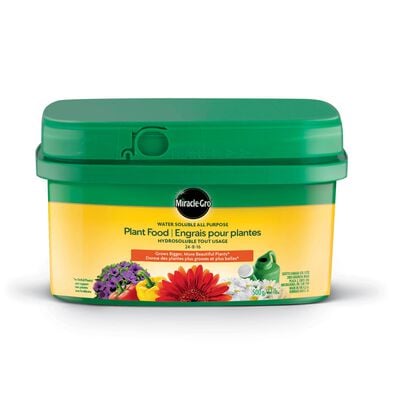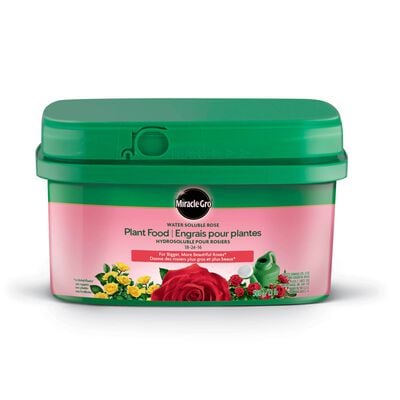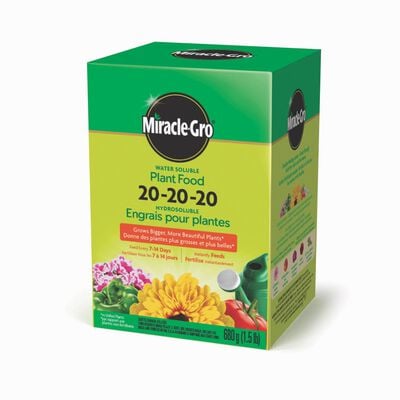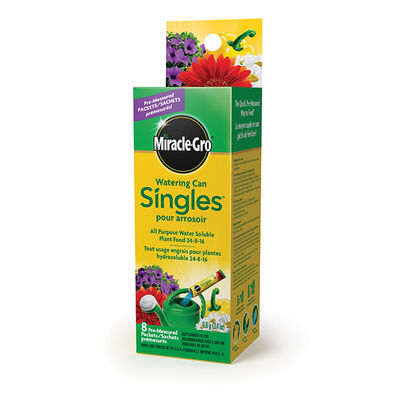
Everything You Need To Know About Feeding Your Plants
Why do we feed our plants?
Plants demand a steady supply of sunlight, moisture, and nutrients to thrive. They absorb sunlight through their foliage and draw moisture and nutrients from the soil through their roots.
You'd never not water your garden, and you should feel the same way about feeding. As the soil becomes depleted, you need to add fertilizer, also known as plant food, to replace the lost nutrients your growing plants continue to need.
Properly fed plants develop stronger, more efficient roots. They also grow to become more robust, more beautiful, and more productive than those that aren't fed. These tips will help you know when to fertilize plants in your garden or containers—but you'll still want to read and follow the directions on the plant food label.
Start in the spring
Nutrient-rich soil helps plants put down healthy roots. Prepare your garden or containers in early spring (but after the last frost) with Miracle-Gro® All Purpose Garden Soil or Miracle-Gro® Potting Mix. Both contain continuous-release plant food to give your vegetables, herbs, and flowers a strong start—plus their first serving of vital nutrients, directly at their roots.
Already-established perennial flowers and herbs also need plant food as they begin to emerge at the start of the growing season. Lightly work a granular fertilizer, like Miracle-Gro® Shake 'n Feed® All Purpose Plant Food, into the surface soil around each plant base, being careful not to disturb the roots or new growth, then water thoroughly to release the nutrients into the soil.

Choose Your Feeding Style
When picking a plant food, you've got some choices.
- If you prefer to feed instantly and while you water, choose a water-soluble fertilizer like Miracle-Gro® Water Soluble All Purpose Plant Food. Measure and mix it directly into your watering can and pour the solution around the bases of your plants, or use with your hose in a sprayer (like the Miracle-Gro® Garden Feeder) for larger areas. Plan to feed every 7 to 14 days.
- Choose continuous-release plant granules, like Miracle-Gro® Shake 'n Feed® All Purpose Plant Food, for less frequent feeding. Sprinkle the easy-to-use, dry granules onto the soil surface, gently rake them into the top few inches of soil, then water thoroughly to start the feeding process.

Feed Regularly (even in the summer)
Plants experience a burst of early growth when they're first planted. Many plant types also have growth spurts in the early or mid-summer, so it's important to replenish nutrients throughout the growing season. After all, you're looking to coax your plants into growing their best and producing the biggest blooms and harvest, right? Annual vegetables and flowers respond especially well to continuous-release feeding that reaches deep down to their roots, promoting bigger, more productive plants.

Consider Plant Food "Flavours"
While all plants will gobble up nutrients from the soil, different varieties require different nutrient balances. Nitrogen grows green leaves and stems. Phosphorus promotes strong roots and abundant, colourful flowers. Potassium helps plants protect themselves from disease, drought, and other stressors. So, while all-purpose plant food is a solid choice if you grow a mix of plant types, consider tailoring your choice if you're all about veggie gardening or prefer to surround yourself with flowers.
Tomatoes, squash, peppers, cucumbers, and other vegetables (and herbs!) will thrive when they're fed every 7 to 14 days with Miracle-Gro® Shake 'n Feed Tomato, Fruit & Vegetable Plant Food.
Promote colourful, abundant flowers in your annuals and perennials by feeding them Miracle-Gro® Shake 'n Feed® Ultra Bloom Plant Food every 3 months during the growing season. Both help flowering plants develop strong roots and more vibrant blooms (vs. unfed).

Watch for Signs of Hungry Plants
When the soil is short on nutrients, you'll see it in your plants. Keep an eye out for warning signs like pale or yellowing foliage, fewer flowers or slower growth than usual, or droopy, limp, weak stems. If you've been watering regularly (but not too much!) and haven't had problems with insects or disease, chances are your plants probably need feeding.

Don't Feed the Weeds!
If you let them, weeds will compete with the plants you actually like for moisture and nutrients. Pull weeds before you fertilize, and concentrate plant food around the bases of your plants, to keep nutrients where they're needed most. Be sure to continue to check for weeds regularly throughout the growing season, pulling ‘em whenever you see ‘em.
Here's one final tip: Keep plant food in an easy-to-see place—like next to your gardening tools—to help keep feeding top-of-mind. (Keep it out of reach of little ones, though!) You can also set reminders on your smartphone. Then, when the time is right, head on out and feed those plants!











